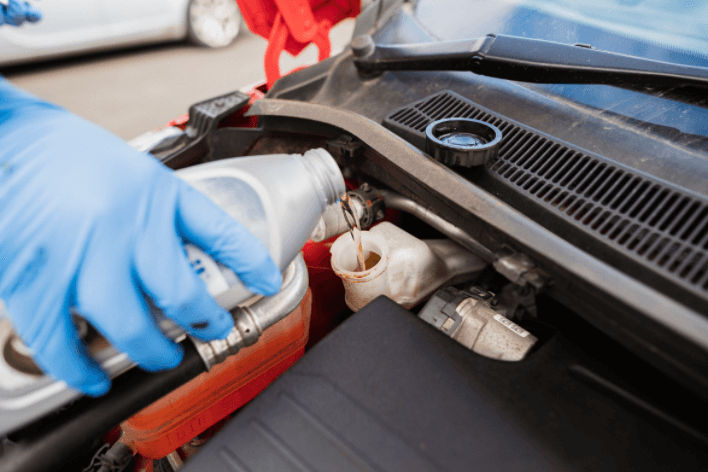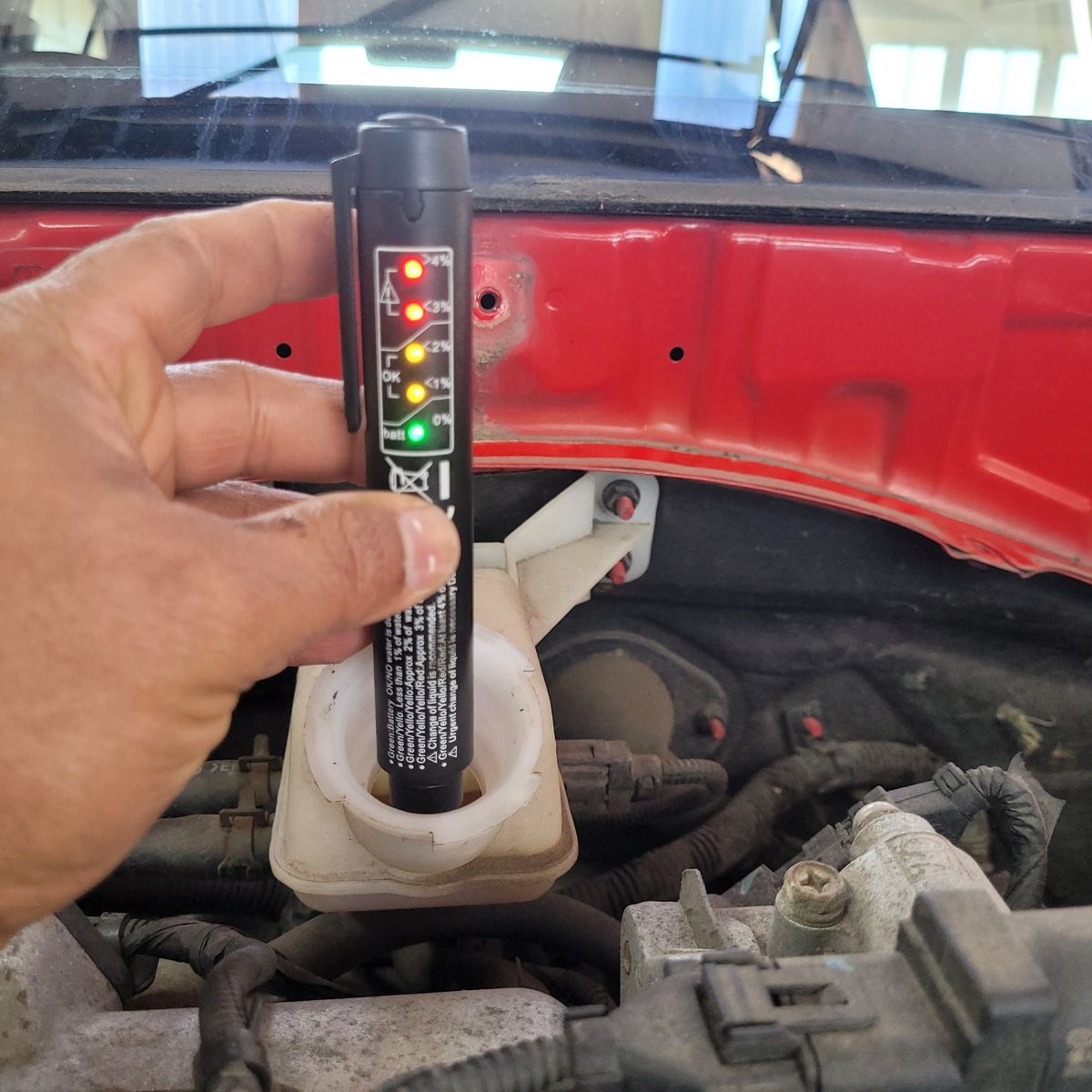Knowing when to put brake fluid in your car can save you from costly repairs and keep you safe on the road. But how do you know the right time to do it?
If you wait too long, your brakes might fail when you need them most. If you do it too often, you could be wasting time and money. You’ll discover the simple signs and best moments to check and replace your brake fluid.
Keep reading to protect your car and yourself with this easy yet crucial car care tip.
Signs Your Brake Fluid Needs Changing
Brake fluid plays a key role in your car’s safety. It helps the brakes work properly by moving force from the pedal to the brake parts. Over time, brake fluid can get old or dirty. It loses its power and can cause problems. Recognizing the signs your brake fluid needs changing keeps you safe and avoids costly repairs.
Brake Pedal Feels Soft
A soft brake pedal means the brakes are not responding well. This can happen when brake fluid absorbs moisture. The moisture lowers the fluid’s ability to transfer pressure. You might feel the pedal sinking or needing more force to stop. This is a clear sign the brake fluid needs a change.
Warning Lights On Dashboard
Brake system warning lights on your dashboard can mean low brake fluid. The light might look like an exclamation mark or the word “Brake.” This alert warns of a problem in the brake system. Check your brake fluid level if you see these lights. Do not ignore them.
Visible Fluid Discoloration
Fresh brake fluid is clear or light yellow. Over time, it turns dark brown or black. This change shows dirt, rust, or water inside the fluid. Dark brake fluid loses its strength and can damage brake parts. Check your brake fluid color regularly to spot changes early.

Credit: www.chapelhilltire.com
Recommended Brake Fluid Change Intervals
Knowing the right time to change your brake fluid helps keep your car safe. Brake fluid wears out over time and loses its ability to protect your brakes. Following the recommended change intervals ensures your braking system works well. These intervals vary by car type, driving habits, and fluid quality.
Manufacturer Guidelines
Car makers give clear advice on brake fluid changes. Usually, this advice is in the owner’s manual. Most recommend changing brake fluid every two years. Some newer models suggest checking the fluid more often. Following these guidelines keeps your warranty valid and brakes in good shape.
Driving Conditions Impact
Driving style affects brake fluid life. Heavy traffic or mountain driving heats the brakes more. This heat can cause the fluid to break down faster. Wet or humid places also speed up fluid wear. For tough driving, change brake fluid more often than usual.
Age Vs Mileage Considerations
Brake fluid ages even if you do not drive much. It absorbs moisture from the air. This moisture lowers the fluid’s boiling point. Experts say to change the fluid every two years. Mileage matters too. If you drive many miles quickly, change it sooner.
Types Of Brake Fluid
Brake fluid plays a crucial role in your car’s braking system. It helps transfer the force from the brake pedal to the brake pads. Different types of brake fluid have different properties. Knowing these types helps you choose the right one for your car. This choice affects your car’s safety and performance.
Dot3, Dot4, And Dot5 Differences
DOT3 and DOT4 are glycol-based brake fluids. They absorb moisture over time. This can lower their boiling point. DOT4 has a higher boiling point than DOT3. It works better in high-temperature conditions. DOT5 is silicone-based and does not absorb water. It lasts longer but is not compatible with DOT3 or DOT4. Using the wrong type can damage your brake system.
Choosing The Right Fluid For Your Car
Check your car’s manual for the recommended brake fluid. Use the fluid type that matches the manual. If you drive in hot areas, choose fluid with a higher boiling point. Avoid mixing different types of brake fluid. Always use clean, fresh fluid. This keeps your brakes working well and safe.

Credit: www.carsales.com.au
How Brake Fluid Affects Brake Performance
Brake fluid plays a key role in how well your brakes work. It transfers the force from your foot on the pedal to the brake parts on the wheels. The quality and condition of the brake fluid affect the whole braking system.
Old or poor-quality fluid can cause weak brakes or even failure. Clean, good brake fluid helps keep your brakes strong and safe. Understanding how brake fluid works helps you know why changing it is important.
Heat Resistance And Boiling Points
Brakes create heat when used hard or often. Brake fluid must resist this heat to work well. If the fluid boils, it creates gas bubbles that stop brake pressure. This makes the brakes feel soft or even fail.
Good brake fluid has a high boiling point. It stays liquid under heat, keeping the brake system responsive. Low-quality or old fluid has a lower boiling point and can boil faster. This reduces brake performance and safety.
Moisture Absorption Risks
Brake fluid absorbs moisture from the air over time. This moisture lowers the boiling point of the fluid. Wet brake fluid can boil at much lower temperatures, causing brake problems.
Moisture also causes rust inside the brake system. Rust can damage parts and cause leaks. Regularly changing brake fluid removes moisture and keeps the system clean. This ensures your brakes stay reliable and strong.
Steps To Replace Brake Fluid Safely
Replacing brake fluid is important for your car’s safety. Old fluid can cause brake failure. Follow these steps to change brake fluid safely and keep your brakes working well.
Gathering Necessary Tools
Start by collecting all needed tools. You will need brake fluid, a wrench, a clear tube, a container, and a brake bleeder kit. Also, have gloves and safety glasses ready. Clean tools make the job easier and safer.
Flushing Old Fluid
Locate the brake fluid reservoir under the hood. Use a syringe or turkey baster to remove old fluid. Fill the reservoir with fresh brake fluid. Attach a clear tube to the bleeder valve on the brake caliper. Open the valve and press the brake pedal slowly. Old fluid flows out through the tube. Close the valve before releasing the pedal. Repeat for each wheel until fluid runs clear.
Refilling And Bleeding Brakes
Keep the reservoir filled during the process. Air can enter the brake lines if the fluid level drops. After flushing, top off the reservoir with new brake fluid. Check each brake line for air by pressing the pedal firmly. If the pedal feels soft, bleed the brakes again. Tighten all bleeder valves securely when done. Clean any spilled fluid immediately to avoid damage.
Common Mistakes To Avoid
Knowing the right time to put brake fluid is important. Avoiding common mistakes helps keep your car safe. Some errors can cause damage or reduce brake performance. Pay attention to these common mistakes to protect your car and yourself.
Mixing Different Fluid Types
Brake fluids come in different types like DOT 3, DOT 4, and DOT 5. Mixing them can cause brake problems. Different fluids have different chemical properties. Mixing fluids may reduce brake effectiveness or damage parts. Always use the type recommended by your car maker. Check the brake fluid label before adding new fluid.
Ignoring Fluid Level Checks
Many drivers forget to check the brake fluid level. Low fluid can cause brakes to fail. Check the brake fluid level regularly, at least once a month. Look for the “MIN” and “MAX” marks on the reservoir. Add fluid only if the level is low. Regular checks help catch leaks or other problems early.
Professional Service Vs Diy Replacement
Deciding between professional service and DIY brake fluid replacement matters. The choice affects your car’s safety and performance. Both options have benefits and risks. Knowing when to trust an expert or do it yourself helps maintain your vehicle properly.
When To Seek Expert Help
Brake fluid is vital for your car’s braking system. Mistakes during replacement can cause brake failure. Professionals have the right tools and skills to do the job safely. They can spot hidden issues during service. If your car shows brake problems, visit a mechanic. Experts handle complex brake systems with care. Avoid risking your safety with DIY if unsure.
Cost And Time Considerations
DIY brake fluid change costs less upfront. You save on labor fees and only buy the fluid. The task takes around 30 to 60 minutes with proper tools. Professionals charge more but guarantee quality work. They complete the job faster and prevent errors. Consider your skills and time before choosing DIY. Sometimes paying more means saving in the long run.

Credit: grimmermotors.co.nz
Frequently Asked Questions
When Should I Replace My Car’s Brake Fluid?
You should replace brake fluid every 2 years or 30,000 miles. Old fluid absorbs moisture, reducing braking efficiency and causing corrosion.
How Do I Know If Brake Fluid Needs Changing?
Signs include a spongy brake pedal, brake warning light, or dark fluid color. Check fluid level regularly to ensure optimal performance.
Can I Add Brake Fluid Anytime?
Only add brake fluid when the level is low. Avoid overfilling and use the type recommended by your vehicle’s manufacturer.
What Is The Best Brake Fluid Type For My Car?
Refer to your owner’s manual for the recommended brake fluid type. Using the correct type ensures system compatibility and safety.
Conclusion
Regularly checking and replacing brake fluid keeps your car safe. Old fluid can cause brake failure and costly repairs. Car makers usually suggest changing brake fluid every two years. Watch for signs like spongy brakes or warning lights. Timely maintenance helps your brakes work well and last longer.
Don’t wait for problems—stay ahead with simple checks. Keep your car’s brake system in good shape for smooth, safe drives. Safe driving starts with proper brake care.

